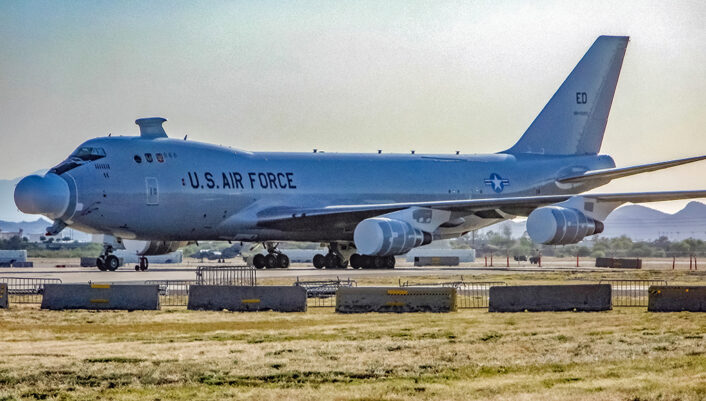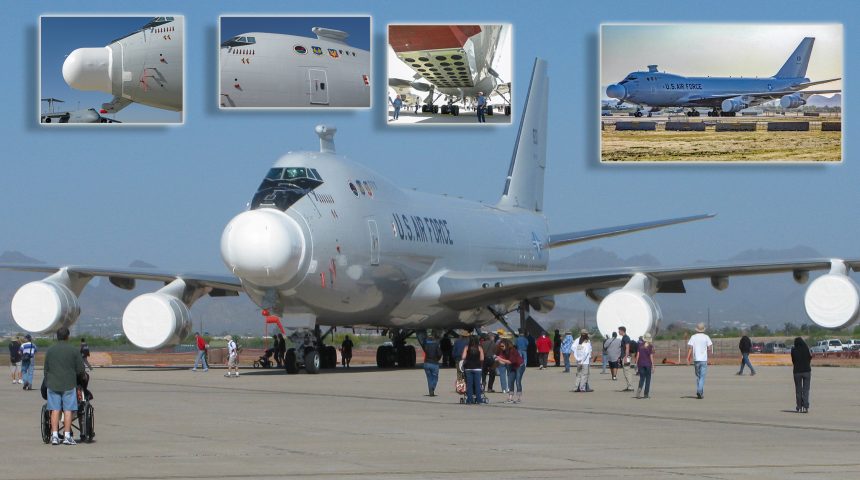Davis-Monthan Airshow in 2012, was the only time the public ever got a close look at the most expensive aircraft in history: the Boeing YAL-1 Airborne Laser 747.
This weekend, Saturday, November 6 and Sunday November 7, 2021, the Thunder and Lightning over Tucson Airshow at Davis-Monthan AFB in Arizona will thrill aviation enthusiasts from around the world with a unique mix of aerial and static displays that can only be presented at one of the most unique military aviation installations on earth. But 9 years ago, in 2012, at this same Davis-Monthan Airshow, there was a very special exhibit that only appeared once, and then disappeared forever.
Davis-Monthan AFB in Tucson, Arizona, is adjacent to the famous 309th Aerospace Maintenance and Regeneration Group (AMARG), the famous aircraft “Boneyard” where retired aircraft are stored for use as parts donors or before their demolition for scrap. In addition to being a massive repository for spare aircraft and parts, the Boneyard is also a living museum, where some of the most fascinating stories in all of aviation sit in quiet repose as their history echoes on into the future long after their demolition.
The Davis-Monthan Airshow is always a special show because of its proximity to unique aviation artifacts and resources like the Boneyard and the Pima Air and Space Museum. But the April, 2012 edition of the show was truly exceptional because of one remarkable, and ephemeral, visitor- a literal “white whale” in aircraft spotting.
The Boeing YAL-1 Airborne Laser Testbed (formerly Airborne Laser) weapons system, aircraft number 00-0001, the only aircraft of its type ever built, was on static display at the Davis-Monthan AFB air show this one time in 2012 before its demolition. It was the only time the public ever got a close look at the most expensive aircraft in history.
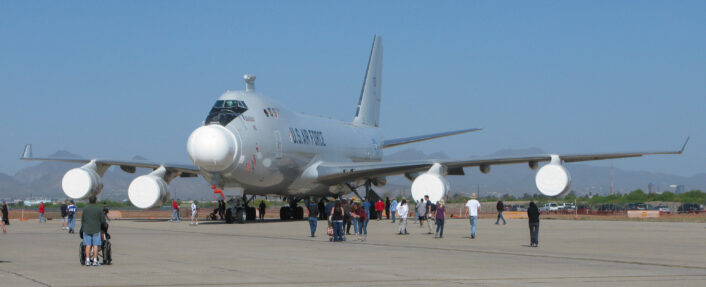
The YAL-1 was a massive airborne laser weapons system aircraft built on a Boeing 747-400F platform. The fiction-like flying laser cannon was intended to shoot down tactical ballistic missiles (TBMs) and potentially even intercontinental ballistic missiles (ICBMs) as part of a theatre and strategic missile defense program that gained momentum during the prior decade in the Reagan administration as a part of the “Star Wars Defense Initiative”.
The program was plagued with complex testing, mixed results and stratospheric cost overruns.
The YAL-1 did, however, eventually experience testing success when, in January 2010, its laser weapon engaged a ballistic missile surrogate simulating a ballistic missile. The test target was called the Missile Alternative Range Target Instrument or “MARTI”. It was “engaged but not destroyed” by the airborne laser fired from the YAL-1 in flight. The program, the most expensive military aircraft in history to date, was beginning to show promise.
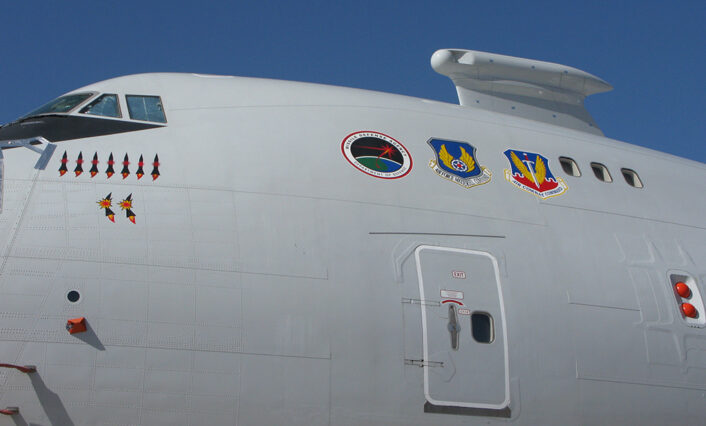
On Feb. 11, 2010, the program experienced more success when the YAL-1 engaged two test missile targets with its massive laser-cannon off the California coast in the Point Mugu Naval Air Warfare Center-Weapons Division Sea Range. During these two tests, the YAL-1 shot down a liquid-fueled ballistic missile and then, only an hour later, “engaged” a solid fuel missile target but did not destroy it because of a “beam misalignment” problem.
An announcement was also made later that, eight days prior to these two tests on February 11, the system had actually engaged and destroyed a solid fuel missile in flight. The results from this round of testing achieved all of the program goals during this phase. The February, 2010 tests of the YAL-10 Airborne Laser Weapons System marked the first time in history that a directed-energy laser weapon was used to destroy a ballistic missile in flight.
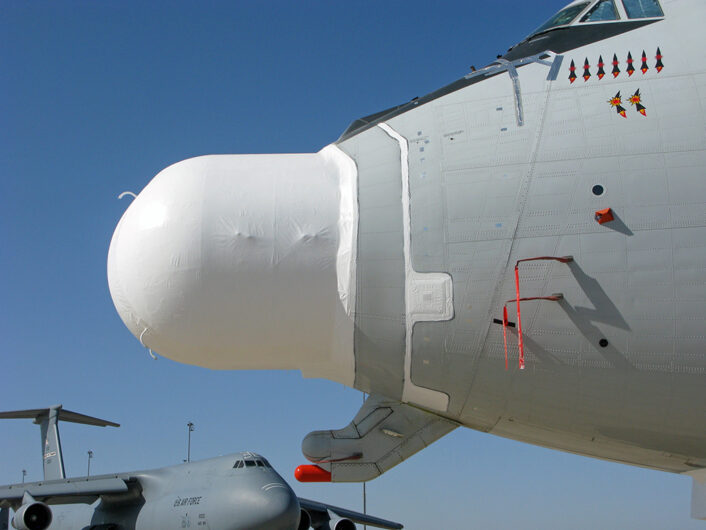
But in December 2011, after $5 billion USD in development and testing, the program was cancelled after being deemed, “not operationally viable” by Air Force Chief of Staff Norton A. Schwartz and from continued budgetary pressure in Washington.
On February 12, 2012, the YAL-1 Airborne Laser Testbed made its final flight to Davis-Monthan AFB in Tucson, Arizona for internment at the AMARG Boneyard and eventual demolition after usable parts and systems were salvaged.
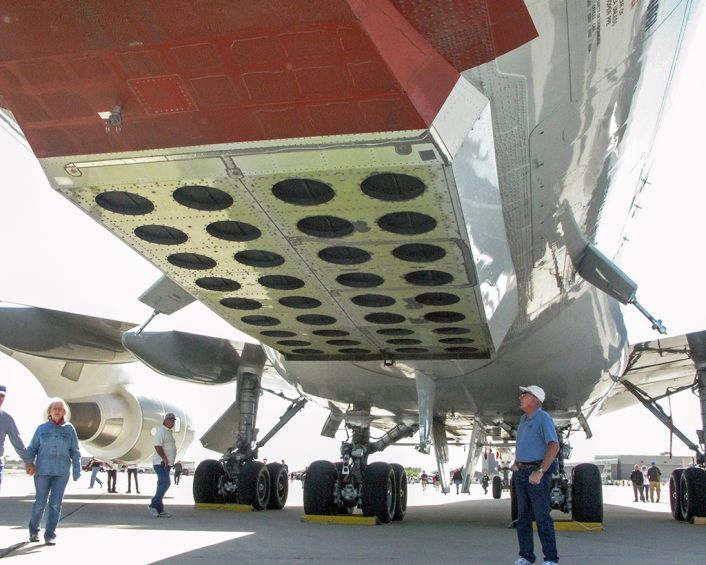
At the time the YAL-1 arrived at Davis-Monthan in February, 2012, I was working at a company on the perimeter of the base and just north of the Pima Air and Space Museum. A friend of mine named Eric and I borrowed a step ladder from work and went over to the fence line at Davis-Monthan to try to get photos of the YAL-1’s arrival, but we didn’t time it correctly and, to our disappointment, missed the aircraft’s arrival before it disappeared into the vast AMARG Boneyard.
Throughout March we stepped up our surveillance of the AMARG fields to see if we could catch a glimpse of the massive but, so far, elusive YAL-1. Then, the week before the Davis-Monthan Airshow, my friend Craig arrived at work with reports that the YAL-1 was, “on the move” and being towed from the Boneyard back to the main flight line at Davis-Monthan, likely for one final and remarkable static display at that coming weekend’s airshow. We were ecstatic. After pressing base insiders for details, it was confirmed that the YAL-1 would be a featured static display at the Davis-Monthan Airshow.
I was the very first person in line for admittance into the airshow at Davis-Monthan that morning, screened through after a young and capable Air Force Security Policeman scrutinized my camera bag. I made a beeline to the YAL-1 to try to grab some photos before the air show crowds surrounded the aircraft. News had spread all over Tucson that something special was going to be at the air show that weekend.
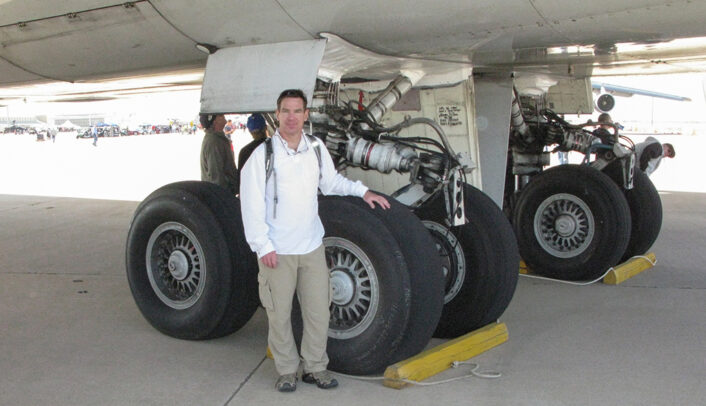
For a few moments, I had the YAL-1 mostly to myself. A few other equally enthusiastic early-bird aviation photographers showed up, and we took turns getting shots of the aircraft. There was no one on hand to describe the significance of the aircraft. As the airshow crowds started to file in and crowd around the aircraft, one of the other photographers graciously offered to shoot a photo of me under the main landing gear of the YAL-1, and I have that photo as a treasured souvenir of this remarkable day at the Davis-Monthan Airshow. It was a truly unique and remarkable weekend at the Davis-Monthan Airshow, and one to never be repeated.
